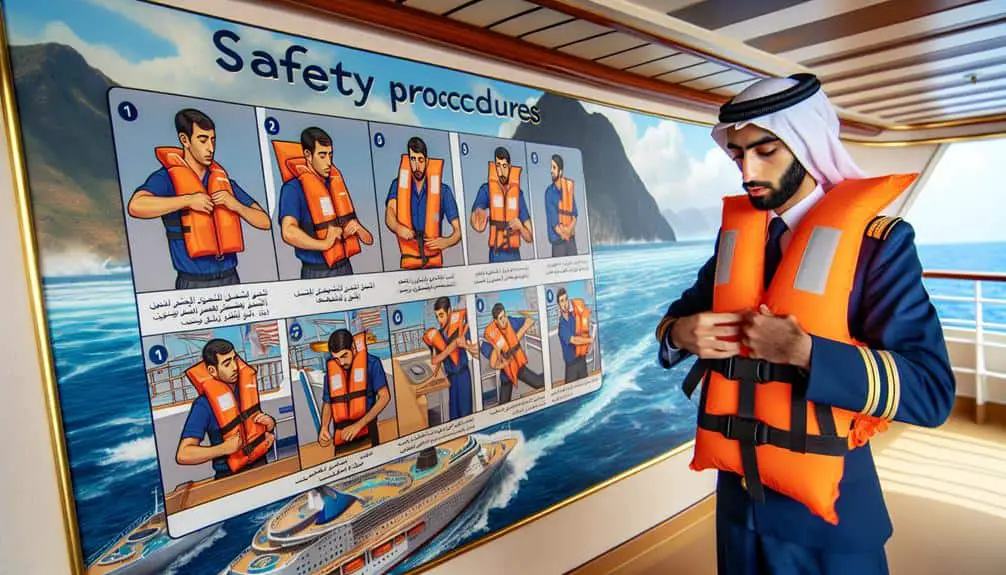During a cruise ship emergency, prioritize safety. Understand emergency procedures, find life jackets and exits. Attend safety briefing, know muster stations. Join safety drills, follow crew instructions. Report emergencies accurately and quickly. Comply with safety protocols, stay calm. Help others and be accountable during evacuations. Your safety is vital during maritime emergencies.
Key Points
- Participate in safety drills to prepare for emergencies.
- Know the location of life jackets, exits, and muster stations.
- Follow crew instructions and emergency protocols diligently.
- Report emergencies promptly and accurately to crew members.
- Stay calm, cooperate, and assist others during evacuations.
Importance of Passenger Awareness
Guarantee your safety by staying informed and alert about emergency procedures on a cruise ship. Safety precautions and emergency preparedness are paramount for all passengers. Familiarize yourself with the location of life jackets in your cabin and the nearest emergency exits. Take note of the safety briefing provided at the beginning of the cruise, as it contains crucial information on what to do in case of emergencies like fires, collisions, or evacuations.
Ensure you understand the signal for emergencies and the different types of alarms that may sound. Follow crew instructions promptly and cooperate with all emergency drills. Be aware of muster station locations and procedures for assembling there during emergencies. In case of an evacuation, know the proper way to don a life jacket and the procedures for boarding lifeboats or other evacuation crafts.
Role of Passenger Safety Drills
Regularly take part in passenger safety drills to familiarize yourself with emergency procedures and ensure you're prepared for any potential crisis onboard a cruise ship. These drills play an essential role in ensuring effective communication and enhancing emergency preparedness among passengers. By actively participating in safety exercises, you become acquainted with important locations, such as muster stations and lifeboat boarding points. This familiarity can make a significant difference during an actual emergency, as you'll know where to go and what to do without hesitation.
During safety drills, pay close attention to instructions provided by the crew. Understanding how to properly wear a life jacket, evacuate the ship, and follow emergency protocols is crucial for your safety. Practice these steps during drills to reinforce your knowledge and build confidence in your ability to respond calmly and effectively in a crisis.
Participating in passenger safety drills isn't just a requirement; it's a proactive approach to safeguarding yourself and others onboard. By taking these drills seriously and engaging wholeheartedly, you contribute to a culture of preparedness that can make a significant impact in emergency situations.
Protocol for Emergency Reporting
Make sure you grasp the process for reporting emergencies promptly and accurately while onboard a cruise ship. In case of an emergency, effective communication and quick reporting are essential for guaranteeing passenger safety. Familiarize yourself with the emergency communication procedures provided during the safety drill at the beginning of your cruise. If you witness an emergency or require assistance, promptly inform the nearest crew member or use the designated emergency communication channels available throughout the ship.
Crew members undergo extensive training to respond efficiently to various emergency situations. They're equipped to handle different types of crises and are trained to act swiftly and decisively to safeguard the safety and well-being of all passengers. When reporting an emergency, provide clear and concise information to the crew, including details of the situation, your location onboard, and any other relevant information that can assist in a quick and effective response.
Compliance With Safety Instructions
Ensuring compliance with safety instructions is paramount for passenger well-being during a cruise ship journey. Safety protocols are put in place to protect passengers in case of emergencies. It's essential to pay close attention to the safety briefing given at the beginning of the cruise. Familiarize yourself with the location of life jackets, emergency exits, and muster stations. Being prepared and aware of emergency procedures can make a significant difference in ensuring everyone's safety on board.
Emergency preparedness involves following instructions from the crew promptly. In the event of an emergency, remain calm and act quickly. Listen to announcements and follow the crew's directions without hesitation. Remember, these safety protocols are designed to keep everyone safe and secure during unforeseen circumstances. Your cooperation and adherence to safety instructions are crucial for a smooth and efficient response to emergencies. By being proactive and responsive, you contribute to the overall safety and well-being of yourself and your fellow passengers.
Accountability in Emergency Evacuations
When faced with emergency evacuations on a cruise ship, your swift response and accountability play a vital role in ensuring the safety of yourself and fellow passengers. In such situations, every individual's actions can make a significant difference in the outcome. Here are three key points to ponder:
- Crew Responsibilities: Understanding the roles and responsibilities of the crew during emergency evacuations is essential. They're trained to guide passengers to safety, provide instructions, and coordinate the evacuation process efficiently.
- Emergency Procedures: Familiarize yourself with the emergency procedures outlined by the cruise line. Knowing how to access life jackets, locate emergency exits, and follow evacuation routes can help you respond effectively in a crisis.
- Maintaining Accountability: Stay aware of your surroundings and follow instructions promptly. Being accountable for your actions and assisting others when needed can contribute to a smoother and safer evacuation process for everyone on board.
Frequently Asked Questions
What Are the Common Types of Emergencies That Can Occur on a Cruise Ship?
During a cruise, emergencies like fires, medical incidents, severe weather, or power outages can occur. Immediate emergency response and adherence to safety protocols are vital. Stay informed, follow crew instructions, and know evacuation procedures for passenger safety.
How Often Are Passenger Safety Drills Conducted on Cruise Ships?
Passenger safety drills on cruise ships are essential for emergency response. They happen regularly to guarantee everyone comprehends safety procedures. By taking part in these drills, you'll be better prepared in case of an emergency at sea.
Are Passengers Allowed to Bring Their Own Safety Equipment on Board?
You'll need to adhere to safety regulations when bringing personal equipment onboard. In emergency response situations, follow safety procedures outlined by the ship. Your gear must meet standards for your safety and the well-being of all passengers.
How Are Passengers With Limited Mobility or Disabilities Accommodated During Emergency Evacuations?
During emergencies, passengers with limited mobility or disabilities are accommodated through accessible evacuation procedures. Crew members assist in addressing mobility challenges, ensuring swift emergency response. Safety drills prepare all passengers, emphasizing inclusivity and efficiency in emergency protocols.
What Communication Channels Are in Place for Passengers to Stay Informed During an Emergency Situation on a Cruise Ship?
During emergencies on a cruise ship, multiple communication channels exist to keep you informed. Updates on safety procedures, evacuation routes, and overall situation are provided through announcements, onboard screens, and crew members, ensuring your awareness and well-being.




